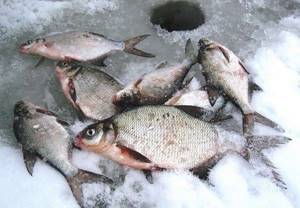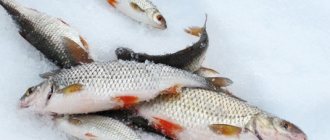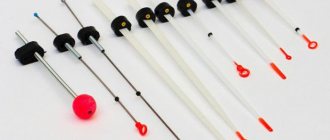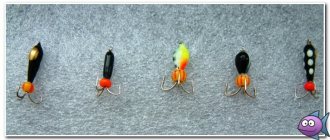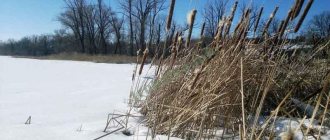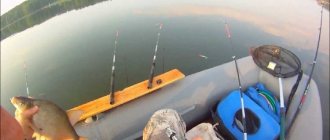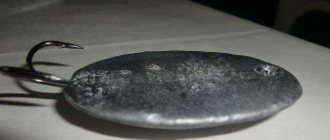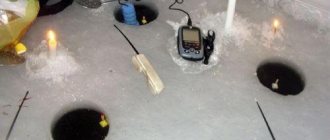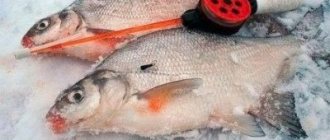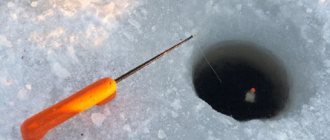One of the options for winter fishing for bream is a jig. There are a huge number of options in the world that really cope with the task so that the fish bite without interruption. Now let’s look in detail at which jigs for bream are more practical.
Expert opinion
Valery Andreevich Sizov
Professional fisherman with 35 years of experience
This individual responds well to the bait of moving species.
Professional fishermen use jigs to catch the big trophies that beginners dream of.
Why is bream quickly caught on jigs, and of different types? Everything is very simple here, the gear imitates real insects, which practically do not differ in color and behavior in the water.
Fishermen force them to create vibrational actions that provoke the fish to call, this is food.
The emanating noises and behavior of the gear in the water make the bream think that this is real prey. The bait plows through the water, attracting the attention of hungry fish.
To make it easier for beginners to understand the essence of the jig, it’s worth telling in more detail. This is a small device with a weight, a sharp hook tip with a hole for fishing line. Manufacturers from different foreign countries create quite a number of species with various forms:
- Droplets;
- Beans and pellets;
- Owsin and bugs.
- Tungsten models
The elements are different; they are light weight and small in size. Therefore, this model can be recognized without much effort. It is used in deep water and strong river currents.
What is the advantage:
- Quick immersion in water;
- The current does not carry the device in the other direction;
- Conducts a spectacular game, which allows you to bring home a decent catch;
- Allows the fish to attract attention. Success is ensured if the remaining parts of the tackle are selected correctly;
- Reliability;
- Practicality.
Jigs with bait
Tungsten options are, of course, good, but the classic ones are no worse than the previous option. Pay attention to elements with different baits.
The advantage allows you to replant other live baits. Such a device is carried out by hand, but gives good results in practice.
If you purchase in specialized stores, their selection is huge. The shape of a pellet or drop always allows you to catch bream.
Fishing for bream in winter from ice
To catch bream in winter with a jig, you need to be able to identify catchable places by drilling several holes and testing jigs. It would be useful to consult with experienced fishermen about choosing a suitable place on a body of water, because winter fishing enthusiasts often visit the same lake or one section of the river regularly. Professionals are fully aware of the behavior of bream in winter and successful methods of catching them.
Bream fishing in winter begins at air temperatures below 10 degrees Celsius, when ice cover on lakes and rivers ends and the ice thickness becomes sufficient for it to be safe to navigate.
Selecting a location
In winter, bream try to stay at a depth of 5 meters, and the places of bottom relief most frequently visited by this fish are changes in depth and edges near the beds of old streams and holes. A clear guideline for successfully catching bream on the first ice is nearby thickets of reeds or reeds that have not yet completely rotted in the water. In such places, bream is found more often at the beginning of winter. And only with the onset of severe frosts will the fish go to a depth of more than 5 meters, where they will remain until spring.
The choice of location also determines the bait for bream, since fishing in shallow water for small fish is successful with some types of bait, while in the middle of nowhere others are required. Understanding this comes to the fisherman with experience, but much can be gleaned from the content of popular books about fishing and from websites on related topics.
Fishing technique
The main technique for catching bream in winter using a jig, as well as large bream, is leisurely oscillations with a slow retrieve. Even if the bream took the bait not from the very bottom, but at a distance from it, the nature of the bite does not change. The nod straightens to its original state and the line underneath it relaxes just as quickly.
In cases where hooking does not give the expected result and the fish leaves, by the type of bite the fisherman is able to guess that he took bream.
This is a prerequisite for keeping fish at the hole by giving an additional portion of bream bait. It is more difficult to notice this feature of the bream bite when fishing in the current, since the bait is carried away from the projection of the hole to the bottom of the reservoir, the fishing line has to be lengthened, and its movements are blurred.
A strong hook can break the fish’s lip, causing an avalanche. To avoid this trouble, make the hooks soft, and further deepen the hook by vigorous retrieving. When a fisherman has mastered strong hooking and has rigid tackle to the point of automaticity, then when catching bream this will play a disservice, especially if bites occur at shallow depths. Here, fishing line breaks and interesting specimens are often lost.
The bream on the hook behaves quite peacefully; strong jerks follow as soon as the fish approaches the hole. If there is a small specimen on the hook, then its desperate behavior will not lead to the escape. But you need to skillfully catch large fish, releasing the line at the moments of the jerk and choosing it again when it weakens. The fisherman selects the fishing line, holding it between the index and thumb of both the left and right hands.
In this case, one hand pulls the line, and the other, slowing down, performs belay. If you do this with one hand, most likely, the large fish will break out with a strong jerk, and it will not be easy to hold it again.
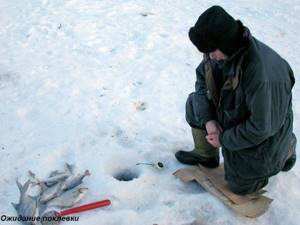
If the bream manages to move a few meters away from the hole, then there is no time to waste thinking about it. By increasing the braking of the line, you need to try to hold the fish in place, and then continue to pull it towards the hole.
It is often discovered at the hole that its size is smaller than the width of the fish. In this case, you cannot do without a hook, but you can use it only at the moment when the bream has calmed down for a while, lay down under the hole on its side, or is simply stuck in its opening. If a fisherman begins to turn purple on a fish that is actively darting, then this most often ends in failure. Either the bream falls off the hook or the line breaks.
It is unlikely that you will be able to get a big fish out of a hole if you do not have stable skills in using a hook. You need to learn how to use it in advance. Most often, fishermen take fish from the hole with two fingers - this is the most reliable way. In this case, only the phalanges of the fingers are covered with mucus, but the palm remains dry.
If the bream has swallowed the hook shallowly, which is typical for fishing with a jig, it is not difficult to remove it after catching. To remove the tip of the hook from the fleshy lip of the fish, you first need to swing it from side to side, grasping the bait with the fingers of one hand and holding the head of the bream with the other. It is important not to break the hook if it is not very strong or if it is poorly soldered into the body of the jig.
You should act even more carefully if the hook is followed by a whole garland of jigs, which have low fracture strength. But when swallowing a jig deeply, you can’t do without tweezers.
How to choose jigs for winter fishing for bream
A jig is an artificial bait that can be used to catch various types of fish. A similar product was “born” from Russian fishermen. As for the name, it appeared thanks to jigs - these are small freshwater crustaceans. In the summer they leave their houses, and during the day they hide in the thickets of rivers.
Some jigs look nothing like bream at all. This is completely normal, since the bait should not only look like live bugs, mosquitoes or flies, but its task is also to attract fish with its active movements. Therefore, outwardly, it may not even resemble anything, but at the same time cope perfectly with the task.
It's no secret that fish feed on those inhabitants that live at the bottom of the reservoir or on the surface. Predators can also profit from those tasty things that accidentally fell into the water.
- As for the jig, by moving it with the required amplitude, the fisherman manages to attract his future prey to the product.
- Therefore, if you want to return with a good catch, you need to try to work as best as possible with the bait.
- If we talk about tackle, then it includes a jig, a nod, a fishing line and also a fishing rod.
How to choose the right jig
You should choose a jig based on the depth of the river where you will be fishing for bream. If the reservoir is shallow - no more than 4 meters, then the ideal option would be “ant”, “drop”, “lentil”, “pear-shaped”.
- If the depth exceeds five meters, then you can forget about a small jig, because such an element will not be able to fully tension the line due to insufficient weight.
- This means that the fisherman can easily miss the bite.
- Much attention should be paid to the color of the bait. There is an opinion that in some reservoirs fish bite well on dark jigs, and in others, on the contrary, on light ones. Perhaps some similar pattern exists, but it does not apply to bream in any way, because this fish prefers dark shades of bait.
- In spring, you can use bait of a dark but bright shade. A red jig is ideal.
- As for the appearance of catchable jigs, they can be different. Metal products are produced with a hook, the size of the latter is no larger than No. 4. If desired, the element is used both as an independent bait, and together with other delicacies that bream are sure to bite on. In this case, it is best to choose steamed grain, pieces of lard, bloodworms, maggots, worms and the like.
In the case when the jig is an independent bait, it should be beautiful and attract fish. It should be noted that during summer fishing the element is selected in larger sizes than in winter. Experienced people advise paying attention to details with a bead, which can lead to a good catch.
How winter fishing is done with a jig
Catching bream in winter with a jig can be complicated by frosts, which force the fish to be less active. Therefore, during this period, the bait is selected as lightly and as small as possible. This is due to the fact that many specimens hide in shallow waters where large parts are not needed.
It must be said that winter baits can be additionally equipped with attachments, although they are optional. They can be used solely as desired.
Bait selection
As for the technique of tying a jig, this is the topic of another article, so it will not be considered. Next we will talk about the details of the gear, which play an important role in the entire fishing process.
The first thing you should pay attention to is the fishing rod. Most often it is purchased in a specialized store. It is inexpensive, so there should be no problems with the purchase. However, some anglers make a handle from wine corks, which is also not prohibited. True, in this case you will have to take care of storing the fishing line on the rod by making a reel or reel.
An equally important part of the tackle is the whip, which will act as a shock absorber when fishing. Thanks to this element, it is possible to regulate the frequency of oscillations when playing with a jig.
- The guard or nod is another amazing and “sensitive” component. Depending on the jig, this detail is also selected, without which there will be no necessary game. Each nod is used only with its own bait.
- As for the fishing line, it must withstand low temperatures.
- It is necessary to choose it based on the expected size of the catch, as well as depending on whether a spoon or jig will be used.
- Often the line used in winter is thinner because the fish move less during the cold season. In summer the opposite is true. If you are fishing with a jig, then it is advisable to give preference to monofilament.
What you need to know about bait
Without good bait there will be no catch - every experienced fisherman knows this. Of course, there is no one recipe thanks to which bream will literally hang on a hook, but there is one that fishermen often use.
It is as follows:
- Be sure to add some maggots or bloodworms to the winter mixture. If you have 500 grams of bait, then you need to take no more than 25 grams of other treats. In cold weather you can’t do without meaty bait.
- If vegetable bait is used, then it should smell pleasant and not have any lumps, because the fish will not even swim to it.
- There is no need to add soil to the plant treat, because bream will not bite it. The soil is suitable with bait containing bloodworms or maggots.
- Be sure to add 100 grams of ground semolina to the “winter delicacy”. 400 grams of crushed biscuits or 350 grams of bran will also work well.
- You can add some coriander seeds to complementary foods.
Technique for catching bream with a jig in winter
In winter, this fish prefers to swallow bait from the very bottom of the reservoir, when, after a short game with a bream jig, the fisherman places it on the ground. At the same time, the nod rises, and the line under it goes into a weakened state. This is how roach and ruff can sometimes peck, but bream never takes it any other way. Fishermen call this type of bite bream.
Bream quickly get used to the monotonous vibrations of the bait and stop paying attention to it. Therefore, the fisherman should learn how to change the tempo of oscillations and their amplitude, and change the speed of the jig from time to time. Instead of measured vibrations, you need to use either various shaking of the bait in the bottom zone, or, having stopped the game, lower the bait to the very bottom and try to move it.
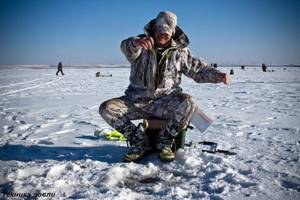
Sometimes fishermen use a vertical one instead of a horizontal one - often the bream grabs the jig while lowering it down. In this case, you cannot rush to hook. Seeing that the jig suddenly stopped before reaching the bottom, you need to wait a short time and only then make a hook. This time is usually only one or two seconds.
There are many techniques that improve biting:
- light impacts of the gear on the bottom of the reservoir;
- weak movements of the bait along the bottom silt;
- slow rise of the jig upwards with continuous frequent vibrations;
- lowering the jig to the bottom with frequent oscillations of small amplitude;
- after stopping all postings, maintain a pause.
If the nod suddenly freezes while retrieving, you need to hook and fish out the hooked fish. The line is pulled out with each slack and given back when the fish jerks strongly. Only when the bream's head is in the hole should you snatch it out of the water, catching it with your hook or fingers.
The best jigs for bream fishing depend on the characteristics of the reservoir and the priorities of the anglers. Everyone has their own views on the optimal weight of the tackle, its shape and the type of bait used. Some consider the best jigs to be drop-shaped or in the form of balls, while others like crystals. There is also no consensus about their color.
Many fishermen prefer “devil” or “goat”, while others refuse these species, using some of their own favorites. The color of the jig is selected depending on the depth of the reservoir and the presence of current and its strength. This choice is influenced by a large number of specific factors of the fishing location and the behavior of the fish.
When the activity of the bream decreases, which happens as the ice thickness increases, it begins to bite better on a stationary bait. At this time, you need to switch from a nod to a regular float; a float fishing rod will give better results. But the float tackle must be made correctly and also used skillfully. This equipment should have a different size from the summer float tackle.

In winter, the rod should be short, and the float and weight should be selected for fishing conditions from ice, and not from the shore. Sedentary bream in the dead of winter pays more attention to those baits that lie motionless on the bottom, and their composition should be as close as possible to natural.
Fishing tactics
When the place for the upcoming winter fishing for bream with a jig has been determined, it’s time to start drilling holes to find bottom changes; it is on the edges and slopes that the bream bite is most likely.
The distance between holes should not exceed 5 meters, but even with such a density it is not always possible to reliably scan the bottom topography in order to detect a gentle slope. In addition, the bream is shy, and after several lowering of the weights on the thread and the work of the ice drill, it will definitely leave this place and return no earlier than in 1.5-2 hours.
It is useful to know some secrets of catching bream in winter. There are no rules without exceptions; in winter, bream can rise from the bottom, sometimes even to the very surface of the reservoir. This occurs during periods of lack of oxygen in the water. At such times, the catch can be excellent near springs or streams flowing into the lake. This is where you can make full use of your favorite jig! Experienced fishermen look for such places even before freeze-up, when everything is clearly visible.
Lure
After drilling the holes, you need to start feeding the fish. There are two classic ways to bait:
- Feed it with bloodworms or a special factory-prepared mixture in feeders, which should be opened one and a half meters from the bottom.
- Use crumbly bait with a special dispenser, which is capable of creating a cone of suspended feed in the water from the hole to the very bottom.
Many fishermen believe that the formation of a stern cone is more conducive to successful fishing, since in it bream can peck at the bait both from the very bottom and in half-water. The fish gets carried away by eating the food suspension and begins to rise higher, sometimes to the ice itself. Experienced bream fishermen use both methods, using bottom feeding in half of the holes and volume feeding in the other.
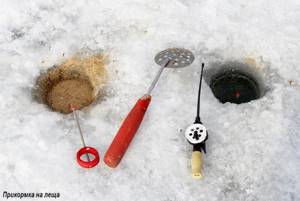
Even the correct location of fish habitat under the ice and the fisherman’s presence of catchable jigs for bream in winter are not a guarantee of success. After all, in nature there are many other factors that influence the behavior of fish and their bite. This includes atmospheric pressure and some other weather factors. But if the fishing rods and baits are chosen correctly, and the bait is placed in a suitable place, the fisherman will not return home without a catch.
Tackle for catching bream in winter
If bream reelless jigs do not allow you to achieve a good bite, you should not waste the whole day, but move on to using other tackle and rigs that are more likely to interest the fish. Having made high-quality feeding and having asked the professionals what color of tackle the bream prefers at a given time, it is important for the fisherman to pay attention to the bait. Very rarely does a fish ignore a bloodworm, but the melting shape of the jig also plays a significant role.
Lately, you can increasingly hear about excellent results when fishing with a crown jig, but any model can fail in a specific situation. Therefore, the best way out when the bite is bad is to try different shapes and types of jigs and attachments.
The most important part of the equipment is the nod
The catchability of the tackle will be influenced by the correct setting of the nod and jig. These two elements are closely related to each other.
- You can install a Mylar or metal (made of a thin elastic plate) nod on the rod's whip. Its length should be adjustable, which will make it easy to adapt to a new jig. To catch bream, it is better to use long nods (more than 10 cm). They will allow the fisherman to give the jig the required amplitude and frequency of vibrations.
- As for the types of jigs, there is no specific catch-catching model. Depending on the body of water and the angler’s priorities, baits of different shapes, weights and colors can work successfully. Some anglers praise jigs in the form of a drop and a ball, others prefer “crystalline”, and still others settle on “devil” or “goat”. The same goes for the color of the bait. The weight of the jigs is selected according to the depth and strength of the current in the reservoir.
You can tempt bream in winter with several baits.
- Most often, anglers use bloodworms. Up to 7 larvae are attached to a sharp hook. When using bloodworms, it is necessary to add it to the bait.
- Loves bream in winter and maggots. The number of larvae on a hook can vary from 1 to 3 pieces. A combination of two larvae: bloodworms and maggots is very attractive. To make this tempting “sandwich”, you must first bait several bloodworms by the head, and then cover the sting with one or two maggots.
- Among other animal baits, the caddisfly should be noted. But using a burdock moth larva is unlikely to work on bream hooks due to the too small size of the bait.
Lure
Feeding is done using a special feeder. It sinks to the bottom and then shakes, the lid opens and the food settles safely at the bottom, right under your hole.
To attract bream to the fishing zone, as well as to keep fish under the hole, bait is required. Here the fisherman has a large selection of mixtures and formulations.
Branded store-bought baits, “tailored” for winter bream fishing, show good results. However, it is not difficult to prepare a homemade appetizing “dish”. It is enough to mix breadcrumbs and ground rolled oats in equal quantities.
At the pond, all that remains is to moisten the mixture and add the animal fraction in the form of a handful of bloodworms.
As for the feeding method, a lot depends on the fishing conditions. At shallow depths and in the absence of current, you can pour the prepared mixture directly into the hole. This may encourage the fish to rise to the upper levels of the water. If there is a possibility that the bait will fall far from the hole, then it is better to use a special feeder to deliver the bait to the bottom.
Selecting a location
The body structure of the bream determines where it stops when feeding. Thanks to its long, protruding mouth, the fish can dig into the bottom soil to find food there. But a tall body makes it difficult to rummage comfortably on a flat surface. Therefore, bream prefers places such as:
- eyebrows;
- sudden changes in depth;
- entrances and exits from pits;
- dumps.
It is these areas of the reservoir that become the most promising for bream fishing. Fish usually move to their favorite sites along the same “paths”. This is where a baited hole will work best.
The method of high-frequency playing between two fingers only works with an active bite. On passive bream, it is better to use smooth movements with an amplitude of 7-10 cm.
You should start catching winter bream by studying the bottom topography. To do this, you need a good ice drill with sharp knives or an echo sounder for winter fishing.
- Most often, you can observe how bream anglers intensively drill a large number of holes, lowering a depth gauge into each of them. The distance between holes ranges from 5 to 10 m. Depth differences of several meters are excellent for catching bream.
- The most effective way to study the bottom when fishing for bream in winter is to use an echo sounder. And it is not at all necessary that the device reflects schools of standing fish. It is enough to see on the screen a comprehensive picture of the bottom relief.
Having found promising areas for fishing, it is necessary to perform a starting feeding. A portion of bait is dropped into each hole, after which the hole should be darkened.
After half an hour, you can start fishing from the first hole. To do this, the jig slowly sinks to the bottom. The upward movement of the jig should be slow with smooth vibrations. At the same pace, the bait sinks back to the bottom.
Among the various techniques that improve bream biting, the following should be highlighted:
- tapping the jig on the bottom;
- slight movement of the bait at the bottom;
- slow rise of the jig with frequent fluctuations to a height of 15-30 cm;
- lowering the bait in the same rhythm;
- pause at the bottom after different wiring options.
The bite of a bream is often expressed in raising the nod or freezing it during the retrieve. With a wrist movement you need to make a hook and start fishing.
When fishing for bream, there is no need to rush; you need to take the fishing line at every opportunity and give it back if the fish makes a strong jerk. When the fish is brought to the hole, it is better to use a hook. It is not a fact that a large bream will easily pass through a drilled hole.
Every bream angler has his own little secrets of ice fishing. They appear only after numerous visits to bodies of water.
Then an understanding of your mistakes comes, and reasonable requirements for tackle, bait and bait appear. And catchy holes are often passed from one angler to another within a week or even a month.
Taking into account all the components of success in winter fishing for bream with a jig, you can achieve a good catch over time.
Source: https://ranoutrom.com/sposoby-lovli/leshh/zimoj-na-mormyshku.html
Winter fishing for bream with a jig
Using different types of jigs, you can choose an option that allows you to get excellent results even in the dead of winter, when bream come to the jig in droves in winter. The main thing is to have a whole range of different types of equipment when fishing and be able to quickly adapt in the absence of a bite. Some will be good for catching bream in December, others - from under the thick January ice.
It is impossible to once and for all choose the only effective jig for any occasion. Those who do not experiment are often left without the desired catch. Only fishermen who are constantly in search of the best types of equipment are almost always successful.
Winter fishing
In winter, for ice hunting for bream, it is better to use landmarks noticed during summer fishing.
Bream does not like fast currents . Therefore, the favorite habitats of this cautious fish are channel holes, ditches, ravines, bays of large rivers, at a depth of 7-12 meters.
When catching bream, you need to be as careful as possible and not create unnecessary careless movements. The vibrations of the jig should be smooth and unhurried. At the slightest suspicious shadow over the hole or a sharp movement of the jig, this cunning inhabitant of the reservoir will simply hide in cover and will not risk returning to its original place for a long time.
Types of jigs for bream
Domestic and foreign industry produces plenty of different jigs for fishermen, many of which are suitable for ice fishing for bream. The main thing is that when you come to the store, do not get confused by the abundance of offers, but know in advance the priorities of the upcoming fishing trip.
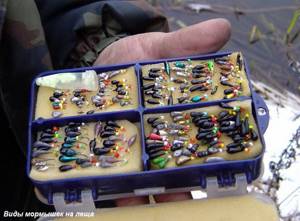
The most commonly used jigs for catching bream:
- ball-shaped;
- drop-shaped;
- pellet;
- oatmeal;
- Uralochka.
Some of them are especially good at the very beginning of freeze-up, others in late winter. It is not enough to experiment with the color and shape of jigs and attachments. The approach to each type of fish is a whole science.
Under thick January ice, when it is still covered with a layer of snow, luminous phosphorus jigs bring good results. By attracting the attention of fish from afar, they allow you to correct even the situation when the fishing spot is poorly chosen.
Jigs
The best jig for bream in winter can only be in the opinion of a particular angler for use in certain fishing conditions. Everywhere there are various tops and ratings of the most catchy jigs for bream, but these are tricks of marketers. You need to collect an arsenal of various options, since you don’t know in advance what will “shoot” today. Large bream will even attack a small balancer or spinner. Some fishermen make jigs for bream with their own hands, since they are not satisfied with what the stores offer. Various kinds of drops, ants, lentils, bugs, diamonds, balls - all this can be useful.
The requirements for bait have already been indicated above. Sometimes in winter even specific baits work, which are often used for catching perch. There is often information that ring jig mounts (semi-offset) work better, but there are also a lot of positive reviews when using standard droplets. Good jigs are those that the angler was able to use competently on a pond, taking into account search, weather, bait, fish behavior and other factors. Therefore, the answer to which jig is better to catch bream in winter is the one that the fisherman was able to skillfully use in these specific conditions of the reservoir and weather.
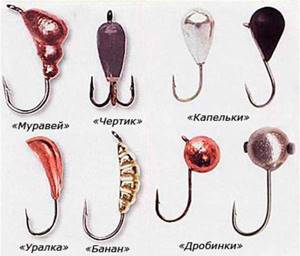
Advantages of catching bream with a jig
The main advantage that comes from catching bream with a jig is, of course, more effective fishing. The fish is attracted by the play of a beautifully designed object and arouses in it the excitement of prey that weakens in winter. But there is another side to the matter - fishing with a jig does not require putting a bait on the hook in the cold before each dive of the tackle. In addition, the nozzle must be securely hidden from frost somewhere under the fisherman’s clothing, from where it must be constantly taken out.
Constantly choosing which jig from the prepared set is the best today and often changing them, you can get pretty tired. If the frost is mild and everything is thought out in advance, then changing jigs on a fishing rod is not so difficult. The main thing for any fisherman is to catch the desired fish and please yourself and your family with a good catch.
What color does bream bite on?
A large individual, it becomes picky in water resources. You won't be able to attract her that easily. Color is of primary importance in catching fish. The main list includes:
- Silver and gold colors;
- Noble black and pure red colors;
- Brindle color with transverse yellow or black lines;
- Copper color.
Professionals recommend basing it on personal experience. Try different options, because what works today may not give the desired bite tomorrow.
If there is no catch, then change the jig, try another option. But first measure the depth.
Choosing the right nod
Fishing with a jig involves the use of special material for the nod. It can be a flat spring or dense lavsan.
For small baits, lengths from 10 cm to 12 cm are used. For large specimens, nods up to 18 cm.
Among other things, the nods are no more than 3 mm wide and up to 0.25 mm thick. The throughput hole for the fishing line entry is 1.5 mm, according to the standard.
On white snow, the nod should not merge with the overall picture. It is distinguished by a bright tip, which indicates a fish is biting.
Expert opinion matters
Most professional fishermen mistakenly believe that the same baits can be used in different bodies of water. Here opinions differ and not without reason.
Let's think logically. Each body of water has its own conditions and different underwater inhabitants. This means that the devices must be of different shapes and sizes. And this is correct, but not vice versa. Experts put forward many versions of this meaning that have been proven in practice.
Experts say that in spring and summer, bream are caught on light-colored products. With the onset of autumn, the reservoirs become darker, which means that the choice of tone is also relevant to a dark color.
Everything in nature is natural. Biting activity is affected by weight and size. For example, in the summer, bream prefer to live in rivers with a small current, and fishermen use a longer rod than in winter.
Imagine a long fishing rod with a small jig, this will cause a lot of inconvenience for the fisherman and the fish’s bite.
Expert opinion
Valery Andreevich Sizov
Professional fisherman with 35 years of experience
For medium depths it is better to use small baits, but for greater depths you should not use light options that will not allow you to feel the fish bite. Simply put, you will miss it.
In winter, it is important to use bait in the form of sandwiches. In this case, you can supplement the attachments:
- Moth larva;
- Dung worms;
- Catchy bloodworms;
- Caddisfly larvae;
- Maggots and underleaves.
We recommend using attachments in the summer, however, you can also do without them. Autumn and winter will not accept this, be sure to use sandwich options. We advise you to conduct your own experiment to see for yourself.
Large bream on a jig in winter
Only by identifying the places of a reservoir or river that attract large breams, their winter stops, can the fisherman be successful. What is characteristic of winter fishing is that it is no longer the fish who is looking for food, but the fisherman who is looking for fish. Only occasionally in winter are large bream able to emerge from their wintering pits onto the adjacent gentle slopes.
You need to know the peculiarities of biting a large bream - first it definitely tries the bait, and only then can it swallow it. All these moments are very compressed in time, but the equipment for catching large fish with a jig must be sensitive enough to record all stages of its bite separately.
The larger the fish, the more careful its behavior. Large specimens are in no hurry to approach the feeding hole; they can be expected here no earlier than in half an hour. But if a large bream approaches, then its bite will be distinguished by decisiveness in its movements. It is important not to completely fish the hole and move on to another one in time. Then the bream remaining at the feeding site can attract larger fish to it.
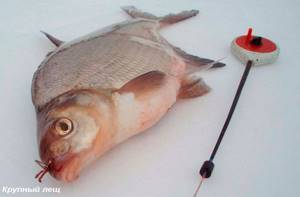
Not every fisherman knows which jig to use to catch big fish. Some species are not easy to find in fishing stores. Often a fisherman has to make bait for large fish himself, after consulting with those who have experience in catching large bream.
You should always prepare for a bite from a large fish. To do this, you should calculate the strength of the fishing line in advance and have a hook on hand, which the fisherman learns to use in advance. Often, in order to pull a large fish onto the ice, you have to drill an additional hole, and here you cannot do it without the help of outsiders.
Where to look for bream in winter
The question of how to catch bream from ice using a jig is secondary. First of all, you should decide where to look for bream in winter. This is especially true when planning fishing on an unfamiliar section of a river or any other body of water. Promising places for fishing are determined by the following criteria:
- Pits and bottom depressions from 4 m;
- Presence of bottom silt;
- Protrusions (“tables”) on dumps;
- Lower eyebrows.
Bream is not found in shallow water or in areas with a lot of rotting wood.
Catching bream with a devil in winter
Catching bream in winter with devil is more productive than with other types of jigs. This type of gear is divided into subspecies:
- the tee is soldered into the jig;
- the hook with the bait is in a suspended state;
- the hook is movable on the fishing line.
The body shapes of the devil come in different shapes, they are usually made of lead, and the mass of jigs weighs from 1 g or more. In order not to miss a good bream, you need to have a corresponding hook on the devil.
Bait fishing with game
The baits described above are used as jigs for bream in winter. One or more bloodworm larvae (less often a worm or maggot) are added to the hook. Fishing is done for the game. Jig tackle requires that the nod and the weight of the jig match. This method is convenient to use when searching, and can also be used together with stationary fishing, next to the holes where fishing rods are installed on a riser.
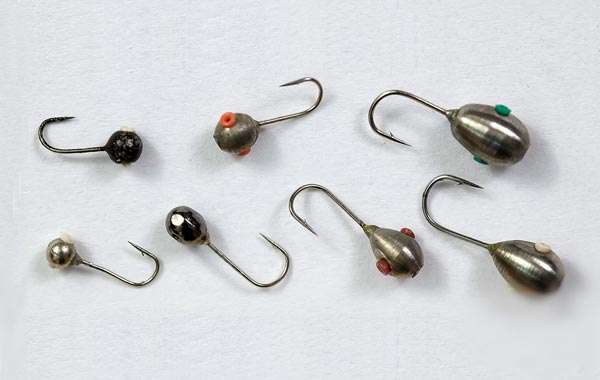
Bait game
When fishing for bream, a smooth, amplitude game is used. This fish does not like fast and sudden movements of the bait. The bream jig should not plan; the correct movements are swaying and tilting. You should experiment with the wiring option. It is better to conduct experiments in the direction of reducing speed and increasing the smoothness of the bait’s movements. Usually the bite occurs during a pause at the bottom, so any moments of the game alternate with stops:
- Slow tapping on the bottom (several times, then pause).
- Tapping and slowly raising 3-5 centimeters, lowering, pause.
- Smooth movements up and down with an amplitude of 7-10 cm.
- Slow rise with trembling of 15-30 cm, immediately the same slow descent, pause at the bottom.
- Slow smooth descent from half a meter, pause, rise again.
- Gent lifts of 3-5 cm, alternating with a pause when the bait is at the bottom.
How to tie a jig to bream
How the jig is tied determines its play and the quality of the hook. The method of tying is also influenced by the nods used on the fishing rod. When tying, it is also necessary to take into account the size of the fish being caught and its energy when jerking.
Sequence of tying the jig:
- the end of the fishing line is threaded into the hole;
- the fishing line is tied in a knot with three to five turns;
- the loop is put on the hook and shifted to its end;
- excess fishing line is cut off.
An easy way to bind for beginners
To tie a bait with a ring, you need to make a line in the form of a loop and wind it around the hook several times. Then thread a free line into the resulting ring and tighten it with a knot. The sausage jig is also tied in this way.
Mothless
There are no special bream jigs for baitless fishing as such; the fisherman needs to use his entire arsenal to select a working one. Many anglers successfully practice winter fishing for bream using the devil. Even the color of beads and beads on bream jigs affects the bite in winter. It is important to understand that catching bream with a reelless bait is more relevant for the first ice and the last ice. You can find fish at this time in fairly shallow areas without using bait.

Making jigs for bream with your own hands
Often fishermen prefer to make reelless jigs with their own hands or remake pre-purchased ones in the store. This is due either to dissatisfaction with the results of fishing, or to the natural design streak in the human soul. When it is obvious that there are fish in the reservoir and the place has been chosen correctly, but bites are rare, you can only rely on the imperfection of the equipment.
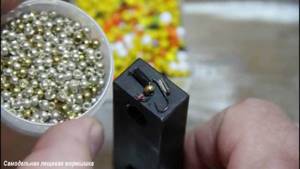
Popular among modifications are bream jigs “klopik”, which are obtained by improving the appearance of ordinary non-reel jigs. It is enough, using waterproof glue, to apply a piece of tulle to the jig, from which individual fibers protrude, and the jig turns almost into a living bug with legs. This similarity gives the fish decisiveness in biting, and the fishing result noticeably improves.
Homemade bream jig “Volnushka”
This homemade reelless jig got its name because of the wavy outer shape that is obtained by straightening copper wire that was previously wound on a thin rod.
If the wire is wound on two rods, wavy bends of a different shape are obtained. The resulting reelless jig can only be called a beautiful jig with a stretch, since its shape is far from geometric perfection. The main thing is that it is catchy, and made with your own hands, it gives the fisherman a share of pride in his skill.
Winter jigs “Sharaga” and “Koza”
The peculiarity of winter nozzle jigs “Sharaga” and “Koza” is the presence of several hooks and significant weight. They are usually made with 2 or 4 hooks, and the materials used are tin and copper rod. “Koza” and “Sharaga” are made using a soldering iron at home. In shape they resemble a simple match, which is why they got the name match jigs.
The popularity of such mothless matches for winter fishing for bream can be explained by the ability to hide in the silt when dropped sharply; this is due to the small cross-section of the body of the jig. But when slowly removed from the silt, they strongly resemble the movement of bottom inhabitants, to which many fish are so accustomed.
Hybrid jig "Cobra" and "Cuttlefish"
These jigs have one or two hooks, and fishermen make them from a plate of stainless steel, brass or copper. If the bite is weak, the fish will definitely bite on them better than on other jigs. They are a hybrid of “Cobra” and “Cuttlefish”, connected by solder into one body.
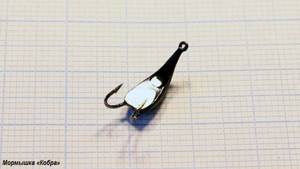
Sports fishermen are not allowed to use these catchy jigs, since in competitions the participants are given equal starting conditions. Athletes can choose equipment for catching bream only from the established list.
Tactics for catching and feeding in winter
Tactics and bait for winter bream are inseparable. Proper use of bait for bream is one of the most important conditions for successful fishing. The flock must first be found. To do this, in promising places, holes are drilled at a distance of 20-30 meters (no closer) and fed. The composition of winter bream bait and the rules for its use in winter are described in detail in our article:
Each hole is then checked, but for this a whole range of winter gear is used, depending on the preferences of the angler and the fishing conditions. In still water, bait is used with a dump truck and a set of fishing rods:
- Winter float.
- Nodding to the boner.
- Mormyshing with a nozzle.
- Mothless.
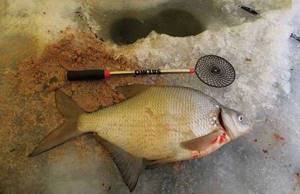
All of these tackles use jigs. During the current, it is better to feed through the second hole, located strictly up from the working hole. It contains a mesh feeder, from which the current washes away the food and forms a feeding spot, respectively, in the direction of the flow.
Bream fishing is most successful in winter at night; the largest specimens only go to feeding areas at night. Therefore, you need to arrive at the reservoir in advance in order to have time to find a catchable place and stay there for the night.
Fishing for bream in December using a jig is more active than in the middle of winter. At such times, fish can be found in fairly shallow (2-3 meters) places. At this time, the rewinder shows itself well. Closer to the dead of winter, the bream finally slides into deep holes, and goes out to feed not far from them, on nearby edges, dumps, tables and banks. It is better to catch it in deep winter exclusively at night (if you need a large bream and not a bream) with bait on a riser from the bottom, periodically checking how it reacts to playing with bait. By the end of winter, the fish become active again, and active methods of searching and fishing in fairly wide water areas come into play again. But these are all matters of personal preference. Some winter fishermen prefer a float, others prefer a nod, and others fish exclusively with no bait. The surest option is versatility, using different gear depending on the conditions and preferences of the fish.
How to catch bream in winter using a jig? Let's consider the main gear and the key points of their installation.
